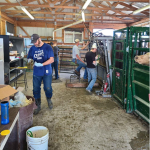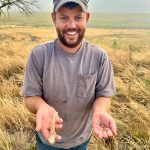SDSU Extension helping cattle producers grow bigger, better beef

Warren Rusche would contend that some of the best cattle in North America are born in South Dakota. That gives Rusche and the rest of the applied feedlot research group at SDSU a unique opportunity, and they are making the most of it.
“We consider ourselves very fortunate that we have access to exceptionally high-quality cattle to do this research with,” said Rusche, Assistant Professor and SDSU Extension Feedlot Management Specialist. “We think our niche is exploring the upper limits of beef productivity and performance.”
Rusche and Zach Smith, associate professor of Animal Science, lead the active research team, which includes 10 graduate students and utilizes several different locations. On campus, there is the Ruminant Nutrition Center, which can hold up to 400 head, and the Cow-Calf Education and Research Facility, which has fluctuating numbers.
The team also typically does one to two studies per year at the Southeast Research Farm by Beresford, which has 24 outdoor pens and eight partially covered pens that usually hold 200-280 head. Rusche said because the research farm has crop production and livestock facilities, it allows them to do unique studies – this spring, for instance, they will test different silage options.
Cattle are an important part of agriculture in South Dakota, and SDSU Extension’s research looks at region-specific ways producers can improve their operations. One of those is by analyzing feeds that are commonly grown and available in the area. Earlage, for example, is a high-moisture, fermented feed that is unique to the Midwest. Rusche said the team is close to publishing their results on their latest study about earlage uses, which will be available to cattle producers.
“In my opinion, livestock feeding, cattle in particular, is one of the more effective rural development tools available for us in rural America,” Rusche said. “This is another way for us to try to help create those opportunities for the citizens of South Dakota.”
Other research includes using processed soybean feedstuffs in growing and finishing cattle, which Rusche said has yielded interesting results. The team has looked at feeding rye to cattle – an area of research where SDSU has led the nation.
They are working on different feeding strategies, and how that affects overall performance; and another current study is looking at growth implants and how they work during the dry-lot phase of production to see how it affects final feeding performance and the meat quality.
Every study, Rusche said, aims at helping cattle producers in and around South Dakota.
“We’re asking questions that apply to beef producers’ daily lives,” Rusche said. “That’s the part of the job I really love. Look at all this new knowledge that’s being generated and think – what are the ways we can use that to make people’s lives and businesses better?”
The team also recently partnered with the North American Limousin Foundation to compare how different sire types fare with extended days on feed to increase the cattle’s final weight.
“We are feeding cattle longer and heavier, and we needed some better data on what that looks like,” Rusche said.
Occasionally, their research yields unexpected spin-offs – while researching feeding rye at the Southeast Research Farm, the team ended up addressing how to keep cattle comfortable during extreme heat.
“We didn’t necessarily intend to do heat stress research,” Rusche said. “Sometimes we have happy accidents where we weren’t necessarily looking to answer that question, and we learned some things along the way.”
The results of that research were posted on extension.sdstate.edu for producers to access. In addition to publishing their results online, the team shares their findings through various events, programs and presentations. Rusche has also been featured on Cattle HQ Live, the SDSU Extension beef team’s podcast.
One of their biggest events is the Siouxland Feedlot Forum, co-hosted with the University of Nebraska-Lincoln and allied industry partners. The annual event brings together experts and industry professionals to present information on industry trends, new research and recommendations in feeding cattle.
Field days, like the Southeast Research Farm Field Day, provide producers another opportunity to see SDSU Extension’s research. Occasionally, Rusche said if enough people are interested in a particular topic, they’ll host a field day specific to that.
Rusche also works one-on-one with both producers and industry professionals – he’s as apt to visit with a nutritionist who works with dozens of producers as an individual cattle feeder.
“I look at the allied industry as an important audience for us, because they’re the ones working with producers on a one-on-one basis,” Rusche said. “We think that’s important for the industry to have some unbiased data. When we provide them with knowledge, then they can apply that to what their customers are doing.”
For more information and to see newly released publications, visit extension.sdstate.edu/agriculture/livestock/beef.

– South Dakota State University Extension
Note: This story appeared in the spring 2025 edition of Growing South Dakota magazine.





